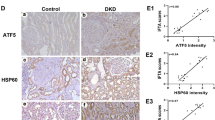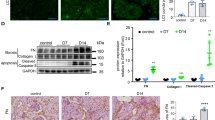Abstract
Advanced oxidation protein products (AOPPs) accelerate the progression of chronic kidney disease. We previously demonstrated that AOPPs induce hypertrophy and epithelial-to-mesenchymal transition (EMT) in human proximal tubular cells (HK-2 cells) through induction of endoplasmic reticulum (ER) stress. However, which pathway of unfolded protein response (UPR) induced by ER stress plays crucial roles in this process remains unclear. In this study, we investigated the roles of the protein kinase RNA-like ER kinase (PERK), activating transcription factor 6 (ATF6), and inositol-requiring enzyme 1 (IRE1) pathways of UPR in this process in HK-2 cells. AOPP treatment induced the overexpression of cleaved ATF6 and spliced form of X-box binding protein-1, and induced the phosphorylation of PERK, eukaryotic translation initiation factor 2α and IRE1. Furthermore, silencing of ATF6 increased E-cadherin and zonula occludens-1 expression, lowered the expression of vimentin, and downregulated total protein content, whereas knockdown of PERK or IRE1 resulted in no difference compared with the scramble siRNA-transfected cells. AOPP-induced phosphorylation of Src, which was reproduced by thapsigargin, an inducer of ER stress, was partly reversed by salubrinal, an inhibitor of ER stress. Furthermore, the Src inhibitor saracatinib effectively blocked AOPP-induced phosphorylation of Src, activation of ER stress, hypertrophy, and EMT in HK-2 cells. Collectively, our results indicate that AOPPs induce the PERK, ATF6, and IRE1 pathways of UPR, and the ATF6 pathway rather than the other two pathways mediates AOPP-induced HK-2-cell hypertrophy and EMT. We also suggest that the ER stress involved in this process is likely mediated by the activation of Src kinase.






Similar content being viewed by others
References
Jha V, Garcia-Garcia G, Iseki K, Li Z, Naicker S, Plattner B, Saran R, Wang AY, Yang CW (2013) Chronic kidney disease: global dimension and perspectives. Lancet 382:260–272. doi:10.1016/s0140-6736(13)60687-x
Bielesz B, Sirin Y, Si H, Niranjan T, Gruenwald A, Ahn S, Kato H, Pullman J, Gessler M, Haase VH, Susztak K (2010) Epithelial Notch signaling regulates interstitial fibrosis development in the kidneys of mice and humans. J Clin Invest 120:4040–4054. doi:10.1172/jci43025
LeBleu VS, Taduri G, O’Connell J, Teng Y, Cooke VG, Woda C, Sugimoto H, Kalluri R (2013) Origin and function of myofibroblasts in kidney fibrosis. Nat Med 19:1047–1053. doi:10.1038/nm.3218
Kriz W, Kaissling B, Le Hir M (2011) Epithelial–mesenchymal transition (EMT) in kidney fibrosis: fact or fantasy? J Clin Invest 121:468–474
Kalluri R, Neilson EG (2003) Epithelial–mesenchymal transition and its implications for fibrosis. J Clin Invest 112:1776–1784. doi:10.1172/jci20530
Liu Y (2004) Epithelial to mesenchymal transition in renal fibrogenesis: pathologic significance, molecular mechanism, and therapeutic intervention. J Am Soc Nephrol 15:1–12
Liu Y (2010) New insights into epithelial–mesenchymal transition in kidney fibrosis. J Am Soc Nephrol 21:212–222. doi:10.1681/asn.2008121226
Carew RM, Wang B, Kantharidis P (2012) The role of EMT in renal fibrosis. Cell Tissue Res 347:103–116. doi:10.1007/s00441-011-1227-1
Inoue T, Umezawa A, Takenaka T, Suzuki H, Okada H (2014) The contribution of epithelial–mesenchymal transition to renal fibrosis differs among kidney disease models. Kidney Int. doi:10.1038/ki.2014.235
Wolf G, Jablonski K, Schroeder R, Reinking R, Shankland SJ, Stahl RA (2003) Angiotensin II-induced hypertrophy of proximal tubular cells requires p27Kip1. Kidney Int 64:71–81. doi:10.1046/j.1523-1755.2003.00076.x
Witko-Sarsat V, Friedlander M, Capeillere-Blandin C, Nguyen-Khoa T, Nguyen AT, Zingraff J, Jungers P, Descamps-Latscha B (1996) Advanced oxidation protein products as a novel marker of oxidative stress in uremia. Kidney Int 49:1304–1313
Witko-Sarsat V, Friedlander M, Nguyen Khoa T, Capeillere-Blandin C, Nguyen AT, Canteloup S, Dayer JM, Jungers P, Drueke T, Descamps-Latscha B (1998) Advanced oxidation protein products as novel mediators of inflammation and monocyte activation in chronic renal failure. J Immunol 161:2524–2532
Liu B, Hou X, Zhou Q, Tian J, Zhu P, Xu J, Hou F, Fu N (2011) Detection of advanced oxidation protein products in patients with chronic kidney disease by a novel monoclonal antibody. Free Radic Res 45:662–671. doi:10.3109/10715762.2011.564167
Li HY, Hou FF, Zhang X, Chen PY, Liu SX, Feng JX, Liu ZQ, Shan YX, Wang GB, Zhou ZM, Tian JW, Xie D (2007) Advanced oxidation protein products accelerate renal fibrosis in a remnant kidney model. J Am Soc Nephrol 18:528–538. doi:10.1681/asn.2006070781
Wei XF, Zhou QG, Hou FF, Liu BY, Liang M (2009) Advanced oxidation protein products induce mesangial cell perturbation through PKC-dependent activation of NADPH oxidase. Am J Physiol Renal Physiol 296:F427–F437. doi:10.1152/ajprenal.90536.2008
Zhou LL, Hou FF, Wang GB, Yang F, Xie D, Wang YP, Tian JW (2009) Accumulation of advanced oxidation protein products induces podocyte apoptosis and deletion through NADPH-dependent mechanisms. Kidney Int 76:1148–1160. doi:10.1038/ki.2009.322
Iwao Y, Nakajou K, Nagai R, Kitamura K, Anraku M, Maruyama T, Otagiri M (2008) CD36 is one of important receptors promoting renal tubular injury by advanced oxidation protein products. Am J Physiol Renal Physiol 295:F1871–F1880. doi:10.1152/ajprenal.00013.2008
Zhang J, Qiu M, Ma Y, Bu Y, Yang L, Tang X (2014) Advanced oxidation protein products induce epithelial-to-mesenchymal transition in cultured human proximal tubular epithelial cells via oxidative stress. Nan Fang Yi Ke Da Xue Xue Bao 34:659–663
Tang X, Rong G, Bu Y, Zhang S, Zhang M, Zhang J, Liang X (2015) Advanced oxidation protein products induce hypertrophy and epithelial-to-mesenchymal transition in human proximal tubular cells through induction of endoplasmic reticulum stress. Cell Physiol Biochem 35:816–828. doi:10.1159/000369740
Kitamura M (2008) Endoplasmic reticulum stress and unfolded protein response in renal pathophysiology: janus faces. Am J Physiol Renal Physiol 295:F323–F334. doi:10.1152/ajprenal.00050.2008
Kimura K, Jin H, Ogawa M, Aoe T (2008) Dysfunction of the ER chaperone BiP accelerates the renal tubular injury. Biochem Biophys Res Commun 366:1048–1053. doi:10.1016/j.bbrc.2007.12.098
Dickhout JG, Krepinsky JC (2009) Endoplasmic reticulum stress and renal disease. Antioxid Redox Signal 11:2341–2352. doi:10.1089/ars.2009.2705
Cybulsky AV (2010) Endoplasmic reticulum stress in proteinuric kidney disease. Kidney Int 77:187–193. doi:10.1038/ki.2009.389
Inagi R (2010) Endoplasmic reticulum stress as a progression factor for kidney injury. Curr Opin Pharmacol 10:156–165. doi:10.1016/j.coph.2009.11.006
Ohse T, Inagi R, Tanaka T, Ota T, Miyata T, Kojima I, Ingelfinger JR, Ogawa S, Fujita T, Nangaku M (2006) Albumin induces endoplasmic reticulum stress and apoptosis in renal proximal tubular cells. Kidney Int 70:1447–1455. doi:10.1038/sj.ki.5001704
Pallet N, Bouvier N, Bendjallabah A, Rabant M, Flinois JP, Hertig A, Legendre C, Beaune P, Thervet E, Anglicheau D (2008) Cyclosporine-induced endoplasmic reticulum stress triggers tubular phenotypic changes and death. Am J Transplant 8:2283–2296. doi:10.1111/j.1600-6143.2008.02396.x
Parsons SJ, Parsons JT (2004) Src family kinases, key regulators of signal transduction. Oncogene 23:7906–7909. doi:10.1038/sj.onc.1208160
Tanjore H, Cheng DS, Degryse AL, Zoz DF, Abdolrasulnia R, Lawson WE, Blackwell TS (2011) Alveolar epithelial cells undergo epithelial-to-mesenchymal transition in response to endoplasmic reticulum stress. J Biol Chem 286:30972–30980. doi:10.1074/jbc.M110.181164
Ulianich L, Garbi C, Treglia AS, Punzi D, Miele C, Raciti GA, Beguinot F, Consiglio E, Di Jeso B (2008) ER stress is associated with dedifferentiation and an epithelial-to-mesenchymal transition-like phenotype in PC Cl3 thyroid cells. J Cell Sci 121:477–486. doi:10.1242/jcs.017202
Moon SY, Kim HS, Nho KW, Jang YJ, Lee SK (2014) Endoplasmic reticulum stress induces epithelial–mesenchymal transition through autophagy via activation of c-Src kinase. Nephron Exp Nephrol 126:127–140. doi:10.1159/000362457
Huang JS, Chuang CT, Liu MH, Lin SH, Guh JY, Chuang LY (2014) Klotho attenuates high glucose-induced fibronectin and cell hypertrophy via the ERK1/2-p38 kinase signaling pathway in renal interstitial fibroblasts. Mol Cell Endocrinol 390:45–53. doi:10.1016/j.mce.2014.04.001
Lan HY (2003) Tubular epithelial-myofibroblast transdifferentiation mechanisms in proximal tubule cells. Curr Opin Nephrol Hypertens 12:25–29. doi:10.1097/01.mnh.0000049812.98789.97
Okada H, Inoue T, Suzuki H, Strutz F, Neilson EG (2000) Epithelial–mesenchymal transformation of renal tubular epithelial cells in vitro and in vivo. Nephrol Dial Transplant 15(Suppl 6):44–46
Humphreys BD, Lin SL, Kobayashi A, Hudson TE, Nowlin BT, Bonventre JV, Valerius MT, McMahon AP, Duffield JS (2010) Fate tracing reveals the pericyte and not epithelial origin of myofibroblasts in kidney fibrosis. Am J Pathol 176:85–97. doi:10.2353/ajpath.2010.090517
Boutet A, De Frutos CA, Maxwell PH, Mayol MJ, Romero J, Nieto MA (2006) Snail activation disrupts tissue homeostasis and induces fibrosis in the adult kidney. EMBO J 25:5603–5613. doi:10.1038/sj.emboj.7601421
Kim MK, Maeng YI, Sung WJ, Oh HK, Park JB, Yoon GS, Cho CH, Park KK (2013) The differential expression of TGF-beta1, ILK and wnt signaling inducing epithelial to mesenchymal transition in human renal fibrogenesis: an immunohistochemical study. Int J Clin Exp Pathol 6:1747–1758
Li Y, Sun Y, Liu F, Sun L, Li J, Duan S, Liu H, Peng Y, Xiao L, Liu Y, Xi Y, You Y, Li H, Wang M, Wang S, Hou T (2013) Norcantharidin inhibits renal interstitial fibrosis by blocking the tubular epithelial–mesenchymal transition. PLoS ONE 8:e66356. doi:10.1371/journal.pone.0066356
Lin JH, Li H, Yasumura D, Cohen HR, Zhang C, Panning B, Shokat KM, Lavail MM, Walter P (2007) IRE1 signaling affects cell fate during the unfolded protein response. Science 318:944–949. doi:10.1126/science.1146361
Tay KH, Luan Q, Croft A, Jiang CC, Jin L, Zhang XD, Tseng HY (2014) Sustained IRE1 and ATF6 signaling is important for survival of melanoma cells undergoing ER stress. Cell Signal 26:287–294. doi:10.1016/j.cellsig.2013.11.008
Lee JY, Chang JW, Yang WS, Kim SB, Park SK, Park JS, Lee SK (2011) Albumin-induced epithelial–mesenchymal transition and ER stress are regulated through a common ROS-c-Src kinase-mTOR pathway: effect of imatinib mesylate. Am J Physiol Renal Physiol 300:F1214–F1222. doi:10.1152/ajprenal.00710.2010
Acknowledgments
This work was supported by the Natural Science Foundation of Guangdong Province (Grant Nos. 10151051501000030, S2011010004053, S2011040003566), the Science and Technical Plan of Guangzhou, Guangdong, China (Grant No. 11C22120703), the Science and Technical Plan of Guangdong, China (Grant No. 2013B021800149), and the National Natural Science Foundation of China (Grant No. 81202842).
Conflict of interest
The authors declare no conflicts of interest.
Author information
Authors and Affiliations
Corresponding author
Additional information
Xun Tang and Xiujie Liang have contributed equally to this work.
Rights and permissions
About this article
Cite this article
Tang, X., Liang, X., Li, M. et al. ATF6 pathway of unfolded protein response mediates advanced oxidation protein product-induced hypertrophy and epithelial-to-mesenchymal transition in HK-2 cells. Mol Cell Biochem 407, 197–207 (2015). https://doi.org/10.1007/s11010-015-2469-0
Received:
Accepted:
Published:
Issue Date:
DOI: https://doi.org/10.1007/s11010-015-2469-0




